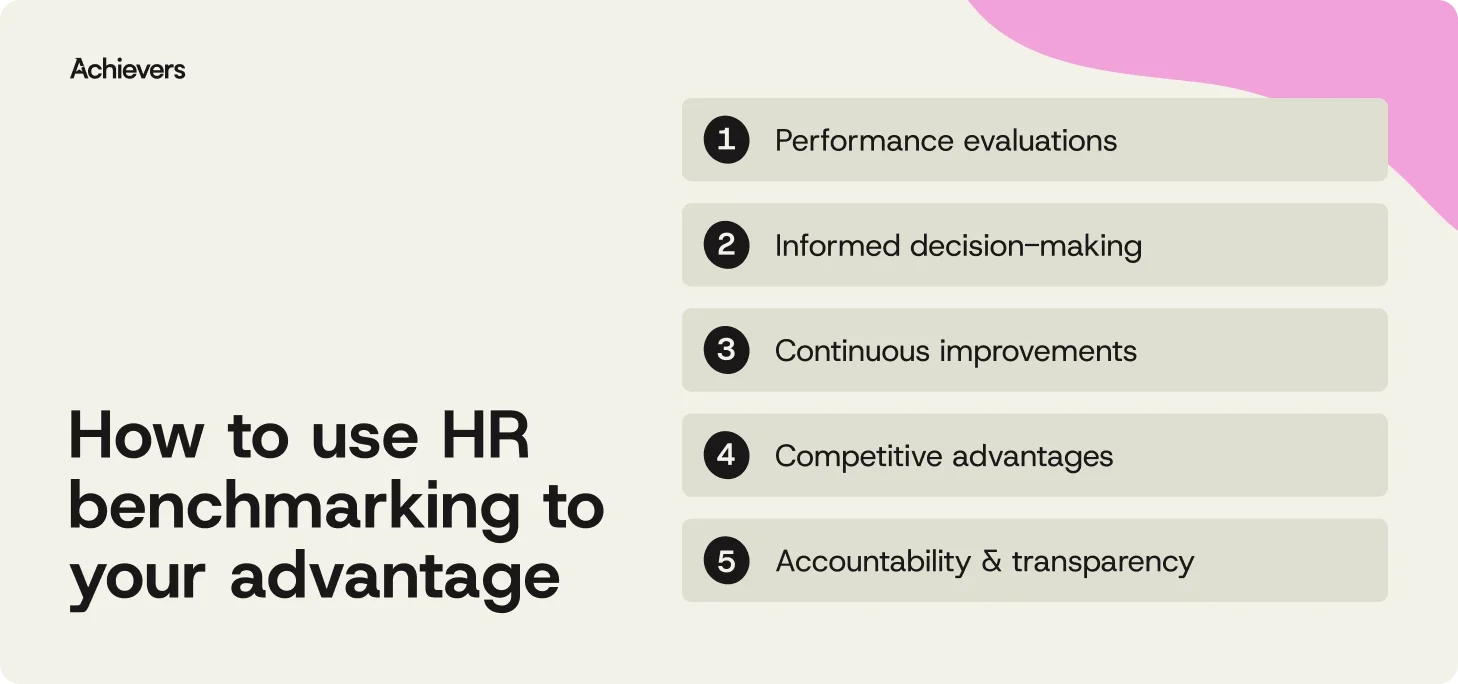Table of contents
Create a culture that means business™
Schedule a demo with an Achievers solution expert today.
When it comes to your people strategy, HR benchmarking shows you how you really measure up. It’s the question every HR team ends up asking: How are we really doing? Not just in a vacuum — but compared to the rest of the industry. Are your turnover rates higher than the norm? Is your time-to-hire slower than it should be? Are some teams quietly crushing it while others struggle to keep up?
When HR benchmarking is done right, it gives you a clear view of where you stand, what’s working, and where to focus next. Let’s break down the basics — and how to get started without getting buried in data.
Types of HR benchmarking
Not all benchmarking is created equal. Depending on what you’re trying to solve — a team-level issue, an industry-wide gap, or a strategic blind spot — the type of benchmarking you choose matters.
Here’s a breakdown of the four main types and how they help HR teams get smarter, faster:
- Internal benchmarking: Compare performance across teams, departments, or regions within your own organization. It’s a fast way to spot best practices, share wins, and identify what’s working (and what’s not) internally.
- External benchmarking: Look outside your organization to compare key HR metrics with peers in your industry. This helps you stay competitive and aligned with evolving standards.
- Competitive benchmarking: Compare your HR metrics to those of direct competitors. This helps you understand where you stand in the market and where you need to level up to stay ahead.
- Functional benchmarking: Look at organizations — even outside your industry — that are solving similar challenges. It’s a smart way to uncover innovative practices and cross-industry insights.
- Strategic benchmarking: Go big-picture. Strategic benchmarking evaluates how your HR strategy stacks up — from how well it supports business goals to how it adapts to change. Ideal during growth, transformation, or leadership shifts.
- Process benchmarking: Focus on the how. Process benchmarking examines the efficiency and effectiveness of specific HR activities — like onboarding, training, or engagement — so you can improve workflows and deliver a better employee experience.
How to use HR benchmarking to your advantage
HR benchmarking is only useful if you do something with it — otherwise, it’s just a very expensive spreadsheet. But when you put it to work, it becomes one of the smartest tools in your HR toolkit.

From performance gaps to strategic decisions, here’s how benchmarking helps you shape your workforce in ways that actually move the needle:
- Performance evaluation: Benchmarking gives you a reality check — not just on how your HR programs are running, but on how they should be. Whether you’re tracking retention, engagement, or internal mobility, benchmarks help you spot what’s working, flag what’s not, and set better goals across the board.
- Informed decision-making: No more gut calls or best guesses. With the right benchmarks, you’ve got real data to back up decisions about where to invest, what to prioritize, and how to align HR initiatives with business strategy.
- Continuous improvements: The best HR teams don’t set-and-forget. Benchmarking makes it easier to keep raising the bar by tracking progress over time — and pushing past it. It also surfaces new ways to evolve your approach, without losing sight of what’s working now.
- Competitive advantages: Want to know how your people programs stack up against the rest of your industry? Benchmarking shows you. And when you can see the gaps, you can start closing them — faster than your competitors do.
- Accountability and transparency: Benchmarks give your team something tangible to rally around. Instead of vague goals and empty promises, you’ve got clear metrics, shared progress, and a way to build trust by showing what’s improving and why.
5 HR benchmarking best practices
Benchmarking only works if the process behind it does. These five best practices will help you get real value from your data — not just another dusty dashboard.
1. Start with a clear goal
Don’t collect data just to have it. Define what you’re trying to learn — whether it’s improving engagement, reducing turnover, or identifying gaps between teams. Use tools like pulse surveys to pinpoint issues early and guide your benchmarking efforts.
2. Pick the right metrics
Focus on the numbers that matter most to your business goals — not just the ones that are easiest to measure. Think: turnover, time-to-fill, DEI representation, or internal mobility. Fewer, more focused metrics = better insights.
3. Make sure your data holds up
Garbage in, garbage out. Benchmarking depends on clean, consistent data. Standardize how you collect it and rely on trusted sources — both internal and external — to make sure you’re comparing the right metrics.
4. Protect privacy and build trust
Respect employee and peer confidentiality, especially when sharing or sourcing external benchmarks. Following data privacy standards isn’t just good compliance — it builds trust and encourages others to share more meaningful insights.
5. Use feedback to keep improving
Benchmarking isn’t a one-and-done project. Keep checking in, measuring progress, and adjusting based on real employee feedback. Tools, like Achievers’ Voice of Employee, make it easy to gather and act on feedback in real time — turning data into decisions, faster.
How recognition turns benchmarks into action
Benchmarking shows you what needs to change — but it won’t spark that change on its own. To actually move the needle, you need to reinforce the right behaviors across your organization. That’s where recognition comes in.
Let’s say your benchmarks show a dip in engagement or a spike in turnover. Recognition gives you a lever to pull immediately — reinforcing belonging, boosting motivation, and making great work more visible. And with Achievers, you can respond quickly — using recognition to drive the changes your benchmarks call for.
Here’s how Achievers helps bridge the gap:
- Reinforce what’s working: Use recognition to scale the behaviors and actions your benchmarks show are driving results — from manager effectiveness to cross-team collaboration.
- Address what’s not: If your data highlights gaps in engagement, belonging, or performance, targeted recognition helps re-align teams and boost motivation fast.
- Make it stick: Organizations using Achievers recognize 2x more often than other platforms — and see up to 5x the impact on engagement, retention, and productivity.
- Act in real time: With employee feedback tools, you can gather insights, spot trends, and adjust recognition strategies on the fly.
- Tie it all together: Recognition moments live where your people work — with global rewards, seamless integrations, and the flexibility to meet employees wherever they are.
How to get reliable external HR benchmarking data
The hardest part of external benchmarking? Getting the data. A lot of it lives behind paywalls, privacy policies, or PowerPoints that never see the light of day. But with the right sources — and a little persistence — you can find what you need.
Here’s how to start:
- Look to trusted sources: Use research firms, industry associations, consulting groups, and government agencies that specialize in HR data. These orgs often run large-scale surveys across industries — just make sure their methodology holds up before using the numbers.
- Tap into your network: Don’t underestimate the power of a good Slack group or post-panel coffee chat. Conferences, webinars, forums, and professional communities can lead to benchmarking insights you won’t find in formal reports — especially if you’ve built trusted peer relationships.
- Dig into published research: Benchmarking gold can show up in whitepapers, academic journals, and industry publications. These often cover niche HR topics in depth — and can offer a fresh lens on trends, practices, and performance standards.
- Join the survey side: Participating in benchmarking surveys doesn’t just help the research — it often gives you early or exclusive access to the results. Keep an eye out for opportunities from reputable firms and HR networks.
- Partner up: Collaborating directly with other organizations in your industry can be a great way to trade insights. Just be sure to set clear boundaries around privacy and data sharing.
- Go custom if needed: If your organization has specific needs or operates in a niche space, consider commissioning a custom benchmarking study. Specialized firms can design something tailored — just be ready to invest the time (and budget) to do it right.
Don’t just benchmark — build a better workforce
HR benchmarking helps you see where you stand. Recognition helps you do something about it.
The smartest HR teams use benchmarking to surface what matters — then use recognition and rewards to reinforce the behaviors that move the needle. From boosting engagement to improving retention, it’s not just about measuring performance. It’s about shaping it. That’s where recognition comes in. By celebrating the right behaviors, you turn insights into action and momentum into lasting change.
Achievers makes it easy. With 2x the recognition frequency and proven impact on engagement, retention, and productivity, it’s the go-to recognition platform for teams that want to move the needle — not just measure it.
Because the best-run businesses don’t just track progress. They recognize it.



